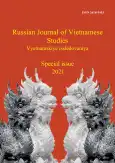The Maintenance of Law and Order in the China–Vietnam Borderlands During the French Colonial Period (1896–1940)
- Authors: Grémont J.1
-
Affiliations:
- French Research Institute on East Asia (Ifrae/Umr8043)
- Issue: Vol 5, No 1S (2021)
- Pages: 34-43
- Section: Scientific researches
- URL: https://ogarev-online.ru/2618-9453/article/view/96256
- DOI: https://doi.org/10.54631/VS.2021.S-34-43
- ID: 96256
Cite item
Full Text
Abstract
The item about border between China and Vietnam is not just a contemporary issue. Its building and its story takes its roots in the past and the colonial period played a major role. This article aims to analyse how the French colonial administration tried to keep order on the Tonkin border. First, the structure of the maintenance of law and order along the border is analysed to better understand how these diverse borderlands areas with a harsh climate and a multi-ethnic population resulted in many issues, giving birth to the challenges of law and order on border. Then, dynamics of cross border criminal activities are studied. The authority of these isolated French colonial troops in the borderlands is usually fragile. In front of this situation, the author will question the colonial administration’s response against the threat of cross border criminality. Military actions and police operations are mixed and order and law is kept thanks to an auxiliary force made up of local populations, the “partisans”, that is the real backbone to maintain law and order in the borderlands.
Full Text
##article.viewOnOriginalSite##About the authors
Johann Grémont
French Research Institute on East Asia (Ifrae/Umr8043)
Author for correspondence.
Email: johann.gremont@yahoo.fr
PhD (History)
France, ParisReferences
- Anonyme (1944). Chefs de postes du Haut Tonkin [Anonymous. Heads of Posts in Upper Tonkin]. Indochine. Hebdomadaire illustré, 201, 6 juillet: 8–9.
- Anonyme (1930). Arrêté réorganisant les services et le personnel de la police de l’Indochine. [Anonymous. Order Reorganizing the Services and Personnel of the Indochina Police]. Hanoi: Imprimerie G. Taupin et Cie.
- Anonyme (1932). Notice sur le 2e Territoire militaire et la région de Cao Bang [Anonymous, Notice on the 2nd Military Territory and the Cao Bang Region]. Hanoi: Imprimerie Lê-Văn, 18.
- Anonyme (1900). Notices sommaires sur les territoires militaires [Anonymous. Summary Notices on Military Territories]. Hanoi: Schneider, 117.
- Blanchard E., Glasman J. (2012). Le maintien de l’ordre dans l’Empire français: une historiographie émergente, in: J.P. Bat, N. Courtin (dir.). Maintenir l’ordre colonial. Afrique, Madagascar, XIXe–XXe siècles [The Maintenance of Order in the French Empire: An Emerging Historiography, in: J.P. Bat, N. Courtin (eds.). Maintenir Responsable Colonial. Africa, Madagascar, XIXth – XXth centuries]. Rennes: Pur.
- De Rugy M. (2018). Aux confins des empires: cartes et constructions territoriales dans le nord de la péninsule indochinoise, 1885–1914 [On the Edge of Empires: Maps and Territorial Constructions in the North of the Indochinese Peninsula, 1885–1914]. Paris: Editions de la Sorbonne.
- Fourniau C. (2002). Vietnam. Domination coloniale et résistance nationale, 1858–1914 [Vietnam. Colonial Domination and National Resistance, 1858–1914]. Paris: Les Indes Savantes.
- Auguste F. (1990). Le mandarin blanc: souvenirs d'un consul en Extrême-Orient, 1886–1904 [The White Mandarin: Memoirs of a Consul in the Far East, 1886–1904]. Textes rassemblés et présentés par Pierre Seydoux. Paris: Calmann Levy.
- Auguste G. (1918). Ma mission en Chine [My Mission in China]. Paris: Plon-Nourrit et Cie. 348 p.
- Goscha C. (1999). Thailand and the Southeast Asian Networks of the Vietnamese Revolution, 1885–1954. Richmond: Curzon Press.
- Grémont J. (2019). La coopération policière transfrontalière franco-chinoise le long de la frontière sino-vietnamienne (1895-1940). Une démarche originale à l’épreuve des préjugés? [Franco-Chinese Cross-border Police Cooperation along the Sino-Vietnamese Border (1895–1940). An original approach to the test of prejudices? Crime, History and Societies, 2: 29–50.
- Grémont J. (2018). Maintenir l’ordre aux confins de l’Empire. Pirates, trafiquants et rebelles entre Chine et Viêt Nam (1895–1940) [Maintaining Order on the Borders of the Empire. Pirates, Traffickers and Rebels between China and Vietnam (1895–1940)]. Paris: Maisonneuve & Larose.
- Guha R. (1997). Dominance without Hegemony: History and Power in Colonial India. New York: Harvard University Press.
- Lafont P.B (dir.) (1989). Les frontières du Vietnam: histoire des frontières de la péninsule indochinoise [The Borders of Vietnam: History of the Borders of the Indochinese Peninsula]. Paris: L’Harmattan.
- Le Failler P. (2014). La Rivière Noire. L’intégration d’une marche frontière au Vietnam [The Black River. The Integration of a Border March in Vietnam]. Paris: CNRS Editions.
- Nguyễn Thị Hải (2015). Monarchie et pouvoirs locaux au: le cas de la marche frontière de Cao Bằng (1820–1925) [Monarchy and Local Authorities in Vietnam: The Case of the Border March of Cao Bằng (1820–1925)]. Thèse de doctorat sous la direction d’Emmanuel Poisson et d’Alain Forest. Université Paris 7.
- Nguyen Thi Hanh (2006). Les conflits frontaliers sino-vietnamiens de 1885 à nos jours [Sino-Vietnamese Border Conflicts from 1885 to the Present Day]. Thèse de doctorat sous la direction de Frank Robert. Université de Paris-1 Sorbonne.
- Beau P. (1908). Rapport sur la situation de l’Indochine de 1902 à 1907 [Report on the Situation in Indochina from 1902 to 1907]. Saigon: Imprimerie commerciale Marcellin Rey.
- Doumer P. (1902). Situation de l’Indochine (1897–1901 [Situation of Indochina (1897–1901)]. Hanoi: F-H Schneider.
- Poisson E. (2004). Mandarins et subalternes au nord du Viêt Nam. Une bureaucratie à l’épreuve (1820–1918) [Mandarins and subordinates in northern Vietnam. A bureaucracy to the test (1820–1918)]. Paris: Maisonneuve et Larose.
- Poisson E. (2009). Unhealthy Air of the Mountains: Kinh and Ethnic Minority Rule on the Sino-Vietnamese Frontier from the Fifteenth to the Twentieth century, in: M. Gainsborough (ed.). On the Borders of State Power: Frontiers in the Greater Mekong Sub-region. London/New-York: Routledge, coll. Routledge Studies in the Modern History of Asia: 12–24.
- Tagliacozzo E. (2005). Secret Trades. Porous Borders. Smuggling and States Along a Southeast Asian Frontier, 1865–1915. New Haven & London: Yale University Press.
Supplementary files








